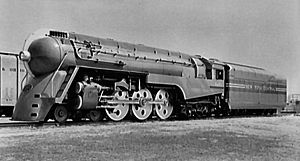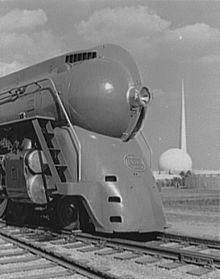- NYC Hudson
-
New York Central Hudson 
One of the ten J-3a Hudsons given a streamlined casing of Henry Dreyfuss' design to haul the 20th Century Limited, on display at the 1939 World's Fair. Power type Steam Builder Alco-Schenectady (265);
Lima Locomotive Works (10)Build date 1927–1931 (J-1);
1928–1931 (J-2);
1937–1938 (J-3)Total produced 275 Configuration 4-6-4 Gauge 4 ft 8 1⁄2 in (1,435 mm) Career New York Central Class J-1, J-2 and J-3 Number in class 205 (J-1),
20 (J-2),
50 (J-3)Disposition All scrapped Hudson was the name given to the 4-6-4 steam locomotive wheel arrangement by the New York Central Railroad (NYC) which was the first to use locomotives of this type in North America.
Contents
History
Although the Milwaukee Road was the first to design such locomotives, naming them Baltics, they didn't get built until after the NYC's Hudsons. The name Baltic for this wheel arrangement was also sometimes used in Europe. Alvin F. Staufer interviewed the Hudson's designer and the NYC's superintendent of motive power, Paul W. Kiefer, in 1961, and asked about the naming of the type. Kiefer's answer is recounted in Staufer's book, Thoroughbreds:
I asked Pat (Patrick E. Crowley, NYC President, All Lines) if we should name the engine or if he cared about that at all. We were already calling the L class 4-8-2s Mohawks, after the Mohawk Valley and Indians. And then, I'll never forget that moment, he just looked at me; the sun was shining in from the West, it was late in the day. He swung around in his huge brown leather chair, away from me. He stared out the window for the longest time. He swung back and stared at me, his chin in his hand. Finally he spoke, "Let's call her the Hudson, after the Hudson River." I agreed immediately (not that it mattered) and that's how it was. The name stuck. It was a natural.
The Hudson came into being because the existing 4-6-2 "Pacific" power was not able to keep up with the demands of longer, heavier trains and higher speeds. Given the New York Central's axle load limits, the Pacific type could not be made any larger; a new locomotive type would be required to carry the larger boiler that Kiefer's research indicated was needed.
Lima's conception of superpower steam as realised in the 2-8-4 Berkshire type was the predecessor to the Hudson. The 2-8-4's 4-wheel trailing truck permitted a huge firebox to be located after the boiler. The resulting greater steaming rate ensured that such a locomotive would never run out of power at speed—a common failing of older locomotives. Applying the ideas of the freight-minded Berkshire type to the Pacific resulted in a 4-6-4 locomotive.
The New York Central ordered one prototype, #5200 from Alco, and subjected her to intensive testing. Passing with flying colors, a fleet of 205 J-1 class Hudsons were built, including thirty for the Michigan Central Railroad and thirty for the Cleveland, Cincinnati, Chicago and St. Louis Railway (“Big Four”). In addition, NYC subsidiary Boston and Albany Railroad ordered twenty J-2 class, ten of them from Lima Locomotive Works (all other NYC Hudsons were built by Alco’s Schenectady works).[1] A later development were the fifty J-3a class “Super Hudson” in 1937–38, with every modern appliance and innovation the railroad could put on them.
They were some of the best known steam locomotives ever. One J-1 locomotive, number 5344, had streamlining applied and named Commodore Vanderbilt.[2] The streamlining was later replaced to match the last ten J-3a locomotives that had been built with streamlining designed by Henry Dreyfuss. Two more J-3a locomotives had streamlining fitted in 1941 for the "Empire State Express.".[3] The streamlined locomotives featured prominently on New York Central advertising for trains like the Empire State Express and 20th Century Limited.
The forte of all Hudsons was power at speed. They were poor performers at low speed and the presence of a booster engine on the trailing truck was an absolute necessity for starting. For this reason, they were generally favored by railroads with flat terrain and racetrack-like routes. After the NYC, the Milwaukee was the biggest fan of the Hudson type, acquiring 22 class F6 and 6 streamlined class F7 locomotives. The Atchison, Topeka & Santa Fe Railway also had sixteen of them. The New Haven Railroad had 10 (#1400-1409) streamlined 4-6-4's built by Baldwin in 1937, nicknamed "Shoreliners," 1400s, or their class I-5. Few roads with hilly terrain acquired any.
A booster, though, was a complicated piece of machinery, liable to trouble. Slowly, the booster fell out of favor with railroads, including the NYC. Instead of a complicated booster, it was deemed preferential to have an extra pair of driving wheels instead, and thus better traction.
Trials of dual-purpose 4-8-2 Mohawks in passenger service sealed the Hudson's fate. A larger locomotive was clearly now required. The Mohawk was nice, but it was still more suited to lower-speed hauling than high-speed power. In 1944, the New York Central received permission from the War Production Board to build a new, high-speed locomotive of the 4-8-4 type, combining all the advantages of the Hudson with those of the Mohawk. Many other railroads had taken to the 4-8-4 in the 1930s, generally calling them Northerns after the Northern Pacific Railway, which had first adopted them. By being a late adopter, the NYC had the chance to build on everyone else's experience.
That locomotive proved to be exceptional, and the type on the NYC was named the Niagara. Some consider them the epitome of steam passenger power in the United States, and possibly the world. Since only 27 were built, however, they only took over the heaviest and most-prestigious trains; most Hudsons labored until the end of steam on the New York Central.
All Hudson units were scrapped when the New York Central dieselized.[3]
See also
Notes
References
- Drury, George H. (1993). Guide to North American Steam Locomotives. Waukesha, Wisconsin: Kalmbach Publishing Company. ISBN 0-89024-206-2.
Categories:- 4-6-4 locomotives
- New York Central Railroad locomotives
- Streamlined steam locomotives
- ALCO locomotives
- Lima locomotives
- Passenger locomotives
- Steam locomotives of the United States
Wikimedia Foundation. 2010.

